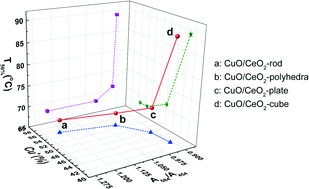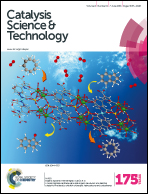A new insight into the morphology effect of ceria on CuO/CeO2 catalysts for CO selective oxidation in hydrogen-rich gas
Abstract
We prepared four ceria supports with different morphologies (rod, cube, plate and polyhedra) by using hydrothermal methods and supported copper oxide catalysts, which are used for selective oxidation of CO in hydrogen-rich gas and characterized by various techniques. The results show that CuO/CeO2-rod and CuO/CeO2-polyhedra exhibit a higher low-temperature catalytic oxidation activity coupled with a broader operating temperature “window” (CO conversion > 99.0%, 95–125 °C and 90–125 °C, respectively) in CO selective oxidation reaction, due to the higher content of the active species Cu+, the smaller copper oxide clusters subjected to a strong interaction with ceria and more oxygen vacancies on the surface of the catalysts. In addition, higher specific surface area, smaller average pore size and concentrated pore-size distribution of mesopores are also beneficial to improve the catalytic performance. However, CuO/CeO2-cube shows the worst performance for CO-PROX, mainly due to the weak interaction between copper oxide particles and the exposed [100] facet of nanocube-ceria.


 Please wait while we load your content...
Please wait while we load your content...